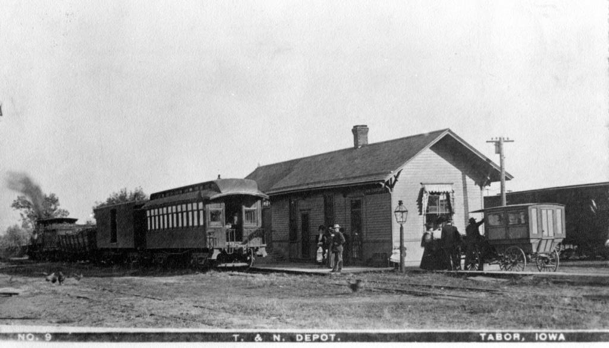Fremont County, Iowa

Hauling Freight on the Tabor and Northern Railroad
by Harry Wilkins
View from the Attic ~ A Weekly Series
Fremont County Historical Society
October 17, 2015
 When we think of railroads, the first thing that usually comes to mind is the rapid movement of passengers. The idea of ordinary people buying tickets, from the station agent, for a trip to
get where they need to go. And of course, that's true, particularly before the age of automobiles. But, one of the most lucrative sources of revenue for trains in the 19th century, as it is today,
was the movement of freight.
When we think of railroads, the first thing that usually comes to mind is the rapid movement of passengers. The idea of ordinary people buying tickets, from the station agent, for a trip to
get where they need to go. And of course, that's true, particularly before the age of automobiles. But, one of the most lucrative sources of revenue for trains in the 19th century, as it is today,
was the movement of freight.
According to Sidney Newlon, author of Train Time (1984), the Tabor and Northern Railway (T&N) began operation in 1887, with two passenger cars and one baggage and freight car.
The twice-daily roundtrip to Malvern, was an immediate, and profitable success with a steady exchange of passengers between the towns to attend social and sporting activities.
Typical was an event on January 12th, 1899, where the T&N carried skaters to Malvern's cold storage plant for 35 cents, round trip, for a day on the ice. The linking of Malvern
and Tabor socially was important, but the underlying commercial benefit of the tiny railroad was the opening of markets for local merchants and farmers wishing to access
the Burlington Railroad's main line, linking Southeast Iowa to Omaha, St. Louis, Chicago and points beyond.
 It soon became apparent, that T&N passenger revenues would be eclipsed by livestock shipments, most destined for the Chicago market. As recounted in Train Time, "as many as twenty
carloads of cattle, and hogs, went out of Tabor a day (with a peak of 28 in the early 1890s)." But the little train carried other commodities as well. In 1895, the T&N reported that there had
been 452 carload shipments in and out of Tabor that year which included "137 carloads of hogs, three cars of iron rails, one car of brick, eight of apples, six of wheat, one of potatoes, 114
cars of cattle, three of household goods, two of oats, one of rye and two of baled hay." Other items moved by the railroad included the U.S. Mail, lumber, bridge iron, coal, concrete, stone,
lime, salt and oil.
It soon became apparent, that T&N passenger revenues would be eclipsed by livestock shipments, most destined for the Chicago market. As recounted in Train Time, "as many as twenty
carloads of cattle, and hogs, went out of Tabor a day (with a peak of 28 in the early 1890s)." But the little train carried other commodities as well. In 1895, the T&N reported that there had
been 452 carload shipments in and out of Tabor that year which included "137 carloads of hogs, three cars of iron rails, one car of brick, eight of apples, six of wheat, one of potatoes, 114
cars of cattle, three of household goods, two of oats, one of rye and two of baled hay." Other items moved by the railroad included the U.S. Mail, lumber, bridge iron, coal, concrete, stone,
lime, salt and oil.
The T&N would meet and surmount the challenges of blizzards, derailments, worn tracks and much more during its 39 years of service, but it was never able to overcome the advent of
automobiles and the highways that were constructed to support them. The mid 1920s saw a steep decline in revenues due to the increased use of trucks to haul freight—passenger traffic
had earlier experienced a notable decline prompting the removal of the single passenger coach. In the summer of 1919, Otha D. Wearin, a student at Tabor College, remembers being
"provided a box for a seat in the freight car, with a pot bellied coal stove for heat in the winter." Although a coach was later put back into service on a part-time basis,
it wasn't enough to save the line. One further indignity remained: The last assignment for the T&N was hauling sand and gravel for the construction of Highway 275, in 1929.
|

 When we think of railroads, the first thing that usually comes to mind is the rapid movement of passengers. The idea of ordinary people buying tickets, from the station agent, for a trip to
get where they need to go. And of course, that's true, particularly before the age of automobiles. But, one of the most lucrative sources of revenue for trains in the 19th century, as it is today,
was the movement of freight.
When we think of railroads, the first thing that usually comes to mind is the rapid movement of passengers. The idea of ordinary people buying tickets, from the station agent, for a trip to
get where they need to go. And of course, that's true, particularly before the age of automobiles. But, one of the most lucrative sources of revenue for trains in the 19th century, as it is today,
was the movement of freight.
